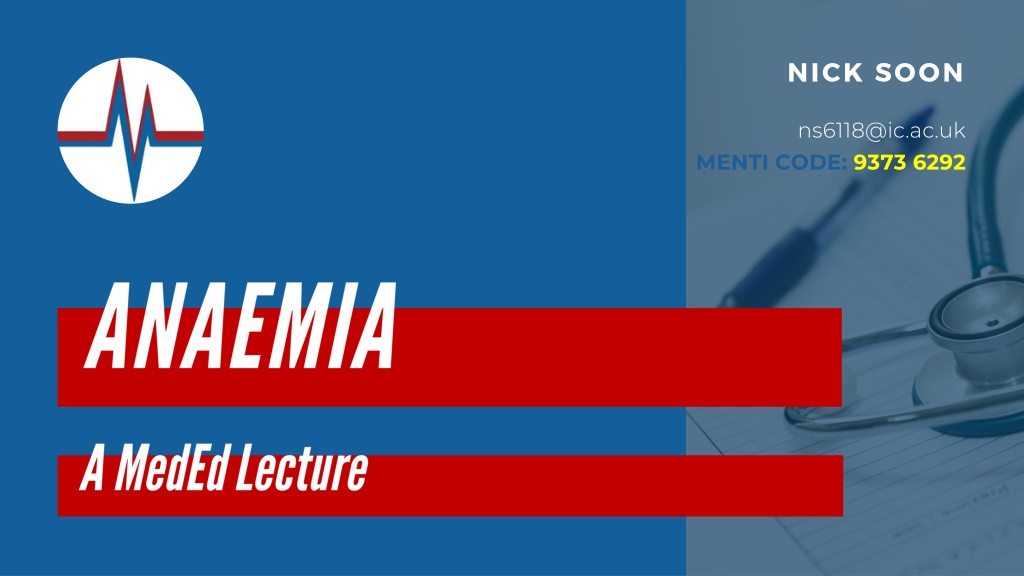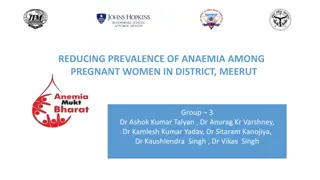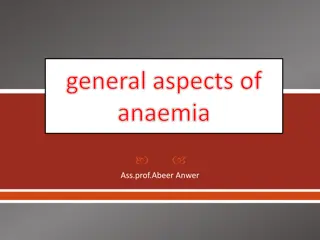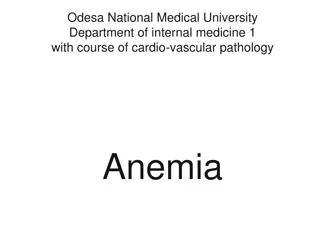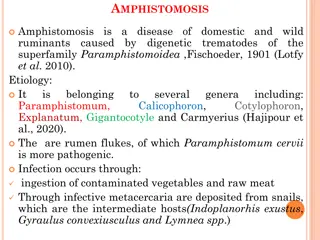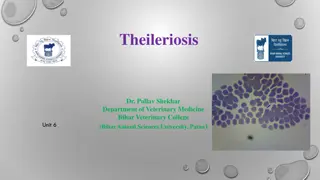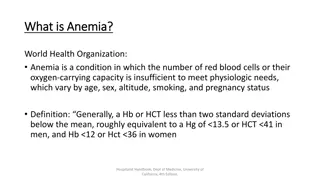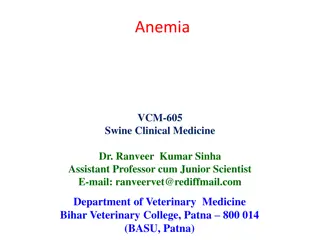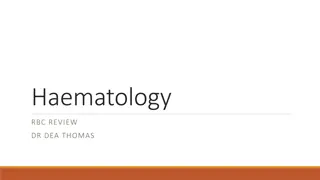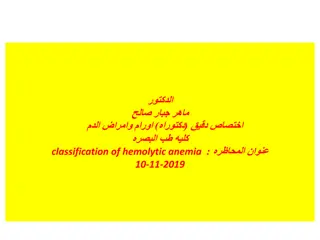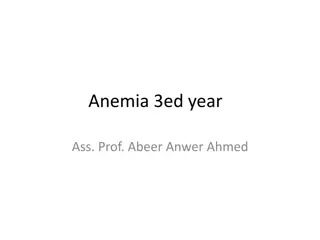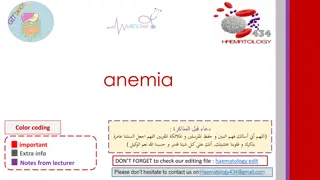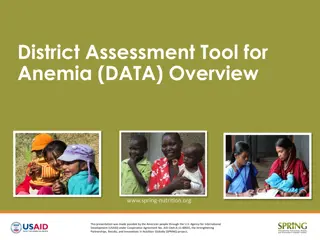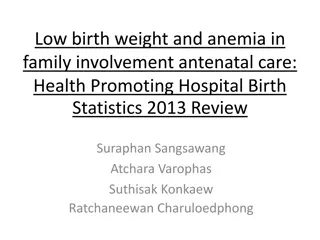Understanding Anemia: Causes, Symptoms, and Diagnosis
Anemia is a condition characterized by low red blood cell count, leading to symptoms like fatigue, pale skin, and shortness of breath. Causes range from nutritional deficiencies to chronic diseases. Diagnosis involves blood tests and examination of red blood cells. This content delves into various types of anemia, their etiologies, clinical presentations, and management strategies.
Download Presentation

Please find below an Image/Link to download the presentation.
The content on the website is provided AS IS for your information and personal use only. It may not be sold, licensed, or shared on other websites without obtaining consent from the author. Download presentation by click this link. If you encounter any issues during the download, it is possible that the publisher has removed the file from their server.
E N D
Presentation Transcript
NICK SOON ns6118@ic.ac.uk MENTI CODE: 9373 6292
Aetiology History Presentation Investigations Management
Anaemia Micro Normo Macro Acute Blood Loss Sickle Cell ACD Myelofibrosis Alcohol Vit B12 Haemolytic Anaemias Thalassaemia IDA Aplastic Liver disease Folate Acquired Congenital Hypothyroid Myelodysplasia HUS Hereditary Spherocytosis Autoimmune Drugs DIC MAHA Infection G6PD TTP
Dan is a 50-year-old man who reports 6kg of weight loss over the last 3 months alongside stomach issues . On examination, he has angular cheilitis, koilonychia and appear pale. A blood film shows hypochromic red blood cells with evident anisopoikilocytosis and multiple pencil cells. What is the diagnosis? a) Anaemia of Chronic Disease b) Thalassaemia major c) Iron Deficiency Anaemia d) Chronic Lymphocytic Leukaemia e) Hyperthyroidism
Dan is a 50-year-old man who reports 6kg of weight loss over the last 3 months alongside stomach issues . On examination, he has angular cheilitis, koilonychia and appear pale. A blood film shows hypochromic red blood cells with evident anisopoikilocytosis and multiple pencil cells. What is the diagnosis? a) Anaemia of Chronic Disease b) Thalassaemia major c) Iron Deficiency Anaemia d) Chronic Lymphocytic Leukaemia e) Hyperthyroidism
Anaemia = low blood Hb Pale Conjunctivae & Skin Fatigue RR HR (severe)
Aniso- Poikilocytosis Pencil Cells Hypochromic & microcytic Blood Film
Reduced uptake Malnutrition Coeliac IBD Unexplained IDA Increased loss GI Malignancy Peptic ulcer IBD Menstruation Colon Cancer Change in bowel Habit PR Bleeding Increased requirement Pregnancy Breastfeeding (+ FLAWS)
Chronic Disease e.g. IBD Cytokines Hepcidin Hepcidin uptake transport Storage Fe Fe Fe Fe Fe FeFe Fe Fe Fe Ferroportin Transferrin Fe Fe Fe Fe Fe Fe Fe Fe Fe Fe Fe Fe Fe Fe Fe Fe Ferritin
Ferritin* TIBC IDA ACD /N *Acute phase protein = during infections ACD is often NORMOCYTIC
Investigations: Microcytic anaemia + Film Normal Iron studies Gel Electrophoresis Management: Regular red cell transfusions every 2-4 weeks with iron chelation regime Thalassaemia Minor Resistance to falciparum Malaria
Alpha from before birth Beta from early infancy HbA1 = 2 + 2 HbA2 = 2 + 2 HbFP = 2 + 2
Sickling is predisposed by: Point mutation Globin Gene Chr 11 Hypoxia Dehydration Acidosis Infection Autosomal Recessive Asymptomatic* Resistance to Falciparum Malaria 20% of tropical Africa population have Sickle cell trait Sickle cell Trait
Howell-Jolly Bodies Sickled Cells
Crisis Management Sickle Acute Painful Crisis Saturate (supportive Oxygen) Antibiotics (if needed) Pain relief Cannula (IV fluids) Crizanlizumab for prevention Acute Painful Crisis Stroke Exchange Blood Transfusion Sequestration Crisis Splenectomy Chronic Cholecystitis Cholecystectomy
Diagnosis: Hb electrophoresis + Blood film Conservative: Trigger avoidance Vaccination Medical: Vaccinations Hydroxyurea Hydroxycarbamide Prophylactic ABx Acute Chest syndrome Dactylitis Surgical: Bone Marrow Transplant (curative) Haemolytic anaemia Priapism Aplastic Crisis
Susan is a 12 year old girl presenting with tiredness and a tingling sensations in her hands. She has recently modified her diet, taking part in Veganuary this year and is following this through. Her mother has been diagnosed with Hashimoto s Thyroiditis. On examination she appears pale. The corners of her lips are notably sore. What is the diagnosis? a) Dietary induced B12 deficiency b)Pernicious Anaemia c) Coeliac Disease d)Folate Deficiency e) Iron Deficiency
Susan is a 12 year old girl presenting with tiredness and a tingling sensations in her hands. She has recently modified her diet, taking part in Veganuary this year and is following this through. Her mother has been diagnosed with Hashimoto s Thyroiditis. On examination she appears pale. The corners of her lips are notably sore. What is the diagnosis? a) Dietary induced B12 deficiency b)Pernicious Anaemia c) Coeliac Disease d)Folate Deficiency e) Iron Deficiency
Folate or B12 Deficiency: Hypersegmented neutrophils Macrocytic cells
Vitamin B12 Pernicious Anaemia IBD & Coeliac Alcohol Malnutrition Folate IBD & Coeliac Anti-folate drugs Pregnancy Alcohol
B12 is fundamental for RBC maturation: Megaloblastic + Neuro signs Glove & stocking parasthesiae Hyporeflexia Romberg s +ve Subacute combined degeneration of the cord +Pernicious Anaemia Anti-Parietal cells Anti-Intrinsic factor B12 reserves last 3-4 years
Be aware of the following other causes: Alcohol Hypothyroidism Liver disease Myelodysplasia Amir Sam: Alcoholics May Have Liver Failure
Which of these must be avoided in individuals with known G-6-PD deficiency? What is the diagnosis? a) Gluten products b)Cow s Milk protein c) Broad beans d)ACE inhibitors e) Smoking
Which of these must be avoided in individuals with known G-6-PD deficiency? What is the diagnosis? a) Gluten products b)Cow s Milk protein c) Broad beans d)ACE inhibitors e) Smoking
Scleral Icterus Pale Conjunctivae & Skin Blood tests: Hb low Haptoglobin low* Unconjugated bilirubin raised LDH raised
Disorders of the RBC itself: Hereditary Spherocytosis Membrane Enzymes G-6-PD Deficiency Haemoglobin Sickle Cell Thalassaemia
BEANS MEANS HEINZ Vulnerable to Oxidative Stress Fava Beans X-linked Recessive
Heinz Bodies Bite Cells (Active Haemolysis) (Previous Haemolysis)
Spherocytes Autosomal Dominant (75%)
Pathogenesis Beta Spectrin or Ankyrin deficiency
Hereditary Spherocytosis Osmotic Fragility Test Aplastic Crisis Lysis Hypotonic Solution Parvovirus B19 + Coombs Test Negative
Sophie is a 14 month old infant. She has a recent 5 day history of abdominal pain which her parents believe is related to food she ate at their recent trip to the state fair. The paediatric registrar on call believes she has now developed an AKI. Her blood tests reveal a normal PT, normocytic anaemia with leucocytosis and thrombocytopaenia. She also has a high serum bilirubin. A section of her blood film is shown: What is the most likely cause? a) ALL b)DIC c) HUS d)Pyelonephritis e) Sepsis
Sophie is a 14 month old infant. She has a recent 5 day history of abdominal pain which her parents believe is related to food she ate at their recent trip to the state fair. The paediatric registrar on call believes she has now developed an AKI. Her blood tests reveal a normal PT, normocytic anaemia with leucocytosis and thrombocytopaenia. She also has a high serum bilirubin. A section of her blood film is shown: What is the most likely cause? a) ALL b)DIC c) HUS d)Pyelonephritis e) Sepsis
Sheared RBCs Microthrombi formation
DISEASE OF EARLY CHILDHOOD EHEC O157:H7 Thrombocytopenia +GI features Abdominal Pain Bloody Diarrhoea HUS MAHA Jaundice Conjunctival pallor AKI
DIC is severe concurrent Clotting and Bleeding Causes include: Pancreatitis Obstetric Complications Sepsis Cancers Trauma ABO Reaction
Bleeding features Petechiae Ecchymoses Haematuria Clotting features Prolonged APTT Prolonged PT Haemolytic features Jaundice Conjunctival pallor Platelets Fibrinogen FDPs D-dimer + Features of underlying pathology
TTP Normal ADAMTS-13 functional ADAMTS-13 dysfunctional
Defunct ADAMTS-13 enzyme: Antiglobulin negative Decreased platelets AKI MAHA Temperature Swinging CNS signs A (rarely complete) clinical pentad
Defunct ADAMTS-13 enzyme: Antiglobulin negative Decreased platelets AKI MAHA Temperature Swinging CNS signs HUS A (rarely complete) clinical pentad Plasmapharesis removes antibodies against ADAMTS-13 and also replaces the enzyme
DIC HUS TTP AKI MAHA Thrombocytopaenia Child (<5) Clinical Pentad Swinging CNS Coombs ve Clotting + Bleeding DAT/Coombs Negative Pl E. coli Shiga Toxin ITU-related Enzyme dysfunction
Auto-immune or Not?
Disorders of the RBCs Environment: Agglutination: Auto-Immune Anti-RBC antigen antibodies DAT/Coombs +ve Warm 37 C IgG antibodies Idiopathic SLE CLL Drugs e.g. Dapsone (Anti-leprosy ABx) Cold 37 C IgM Antibodies Idiopathic Mycoplasma Mononucleosis Infection Plasmodium falciparum malaria (Blackwater fever)
Please fill in the feedback form! https://imperial.eu.qualtrics.com/jfe/form/ SV_cUQS3XNcJLOwJoi
Donald is an 85 year old owner of a nuclear powerplant. He is hypertensive and managed with Amlodipine. He is referred to his doctor after his dentist notices he appears cachectic and his dentures no longer fit. On examination, Mr Burns has massive splenomegaly. A blood test and subsequent bone marrow biopsy are carried out: RBC Low Hb Low WCC Low Plts High What is the most likely cause of these findings? a) Multiple myeloma b)Acute myeloid leukaemia c) Essential thrombocytosis d)Myelofibrosis e) Myedlodysplasia Film: poikilocytosis Biopsy: dry tap
Donald is an 85 year old owner of a nuclear powerplant. He is hypertensive and managed with Amlodipine. He is referred to his doctor after his dentist notices he appears cachectic and his dentures no longer fit. On examination, Mr Burns has massive splenomegaly. A blood test and subsequent bone marrow biopsy are carried out: RBC Low Hb Low WCC Low Plts High What is the most likely cause of these findings? a) Multiple myeloma b)Acute myeloid leukaemia c) Essential thrombocytosis d)Myelofibrosis e) Myedlodysplasia Film: poikilocytosis Biopsy: dry tap
Fibrosis in response to a BM malignancy >65 years old BM Aspirate: dry tap fibrosis Blood film: Tear drop cells Radiation
